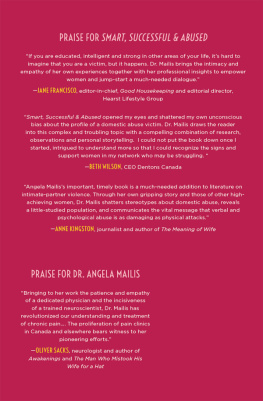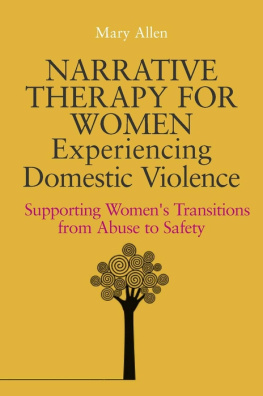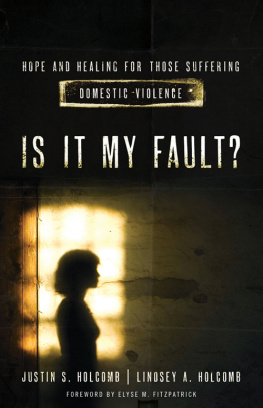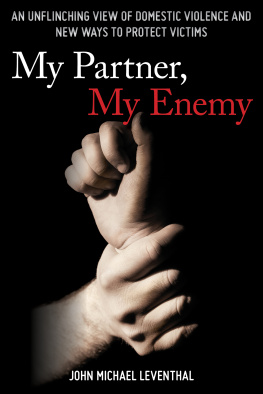SMART,
SUCCESSFUL &
ABUSED
SMART,
SUCCESSFUL &
ABUSED
The Unspoken Problem
of Domestic Violence and
High-Achieving Women
DR. ANGELA MAILIS

Sutherland House
416 Moore Ave., Suite 205
Toronto, ON M4G 1C9
Copyright 2019 by Angela Mailis
All rights reserved, including the right to reproduce this book or
portions thereof in any form whatsoever. For information on rights and
permissions or to request a special discount for bulk purchases, please
contact Sutherland House at
Sutherland House and logo are registered
trademarks of The Sutherland House Inc.
First edition, September 2019
If you are interested in inviting one of our authors to a live event or
media appearance, please contact
and visit our website at sutherlandhousebooks.com for more
information about our authors and their schedules.
Manufactured in Canada
Cover designed by Lena Yang
Book composed by Karl Hunt
Library and Archives Canada Cataloguing in Publication
Title: Smart, successful & abused : the unspoken problem of
domestic violence and high-achieving women / Angela Mailis.
Other titles: Smart, successful and abused
Names: Mailis, Angela, author.
Description: Includes bibliographical references.
Identifiers: Canadiana 2019012864X | ISBN 9781999439576 (hardcover)
Subjects: LCSH: Abused women. | LCSH: Women in the professions. |
LCSH: Spousal abuse. | LCSH: Family violence.
Classification: LCC HV6626 .M35 2019 |
DDC 362.82/92dc23
ISBN 978-1-9994395-7-6
This book is dedicated to Dr. Elana Fric-Shamji,
whose tragic death was the single most
compelling reason for it to be written
I AWOKE EARLY ONE Saturday morning to find a message from a medical colleague on my cellphone: Did you hear about Mo? A CP24 news channel link was attached. I opened it and stared in shock. The previous day, Friday, December 2, 2016, the body of Dr. Elana Fric-Shamji, a Toronto family physician, had been found in a discarded suitcase. Her husband, Mo Shamji, a Toronto Western Hospital neurosurgeon, was charged with first-degree murder.
I screamed in disbelief, bringing my husband, Norm, running into the room. All I could say was This is not possible! I suddenly remembered that yesterday morning, the day Elanas body had been found, my younger son, Alex, a chiropractor at my Pain and Wellness Centre, had called me with a strange message. He had had to cancel his first appointment because a police investigation had closed his route to work. Now I understood why: Elanas body had been discovered close to my sons Kleinburg home and to my clinic in Vaughan, north of Toronto.
I did not know Elana Fric-Shamji but I knew her husband, Mo Shamji, very well. He had been a colleague and a collaborator at Toronto Western Hospital, where I had spent most of my professional life as founder and director of the Comprehensive Pain Program. The news of Elanas murder and the charge against Mo horrified me.
I was not alone. By 7:30 that morning, my phone started ringing with calls from stunned members of my former staff at Toronto Western, as well as from patients whom Mo and I had shared. None of us could believe the news. None of us could fathom that the quiet, aloof man we thought we knew, this very talented neurosurgeon, could be capable of what the media was reporting.
The news shook me to the bone. For the next few nights, I would awaken over and over, thinking of what had happened. In the morning, I would devour newspapers and watch TV news, thirsty for information. CTV News reported, from a source close to the investigation, that Elana Fric-Shamjis family and friends were alleging that her twelve-year marriage had long been a violent relationship. In the spring of 2005, police had been called to the couples home in Ottawa, where Mo was attending medical school. Mo was charged with one count of assault and two counts of uttering threats. Allegedly, he had thrown Elana down the stairs when she refused to have an abortion, causing her to flee with their baby daughter. A peace bond, forbidding Mo from approaching Elana, was imposed by the courts. It was removed within three months to allow Mo to travel abroad for more training, something he could not do if he had a criminal record.
Elanas friends and colleagues began to approach me directly because they knew I had worked closely with Mo for several years. At a medical conference, a physician told me that Elana had been one of her brightest colleagues, very intelligent, and with leadership ability; however, after she had met Mo, her career took second place. Everything was now about his career. My colleague went on to say that she and all of Elanas friends had expected something bad was going to happen to Elana. But, she added, never that bad. They used to call Mo wacko and he was known to be extremely controlling.
More chilling details emerged through the media about the life and death of this thirty-nine-year-old doctor and mother of three. The Globe and Mail reported on April 4, 2017, that Elanas parents, Ana and Joseph Fric, had stated in civil proceedings that Dr. Shamji had committed another serious assault on Elana two months before her murder. This, along with Elanas knowledge of Mos involvement with another woman, had prompted her to file for divorce. A week before her death, Elanas lawyer had sent Dr. Shamji a formal email requesting details of his financial assets.
Dr. Elana Fric-Shamjis murder shook the whole University Health Networkthe largest such network in Canada, comprised of five hospitals, including Toronto Western, where Mo and I had worked. Besides being a well-respected family physician, beloved of colleagues and patients, Elana had made her mark as a very active member of the Ontario Medical Association. At a May 2017 Canadian Pain Society conference that I attended in Halifax, her name came up often. I tried to find out if anyone (colleagues, nurses, secretaries) had observed anything out of line in Mos behavior. One recalled an incident at a scientific conference, a year or so previously. During dinner in a posh restaurant, Mo had ordered a bottle of wine, costing close to $250. When he didnt like it, hed made a loud scene, demanding that the wine be changed. According to this colleague, the whole group was looking at the floor throughout the altercation, shocked by Mos display of serious anger for such a small thing. That had made no sense to anyone back then. Now, it made total sense to all of us.
Other observations that had seemed insignificant took on sinister shape and meaning. I was told that Mo occasionally appeared at work with bruises that he attributed to hitting a door or slipping, and so forth. In hindsight, these injuries suggested frequent altercations in which Elana had defended herself by hitting back. Most shocking, apart from Elanas murder itself, was the fact that Mo had gone to the hospital the next morning and operated all day, as if nothing had happened. When nurses had commented on bruises to his face, he had again downplayed them. I was also told that several of his co-workers had had to take trauma counseling after Elanas murder, partly out of disbelief that Dr. Shamji was able to operate without any signs of emotional distress.
According to a 2015 Statistics Canada study, almost 92,000 Canadians were victims of intimate partner violence, representing 28 percent of all victims of police-reported violent crime. Four out of five of these were womenabout 72,000 females. Of the 964 intimate-partner homicides between 2005 and 2015, 74 percent were committed by a marital or common-law spouse.
In the United States, women account for 85 percent of victims of intimate partner violence. One in four women experience severe violence, bringing the total number of American women who are physically attacked by an intimate partner every year to 4,774,000. A woman in the United States is beaten every nine seconds and one in seven women has been injured by an intimate partner (the same proportion, incidentally, that have been stalked). Intimate partner violence accounts for 15 percent of all American violent crime. Three women are murdered every day by a current or former male partner. In 2011, 926 women were murdered by an intimate partner. Of those, 264 were killed during an argument. Intimate partner violence is the leading cause of female homicide
Next page









